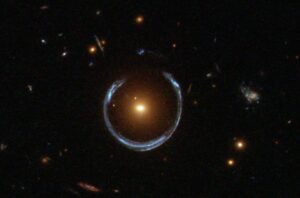Even at the scale of the cosmos, nature remains brutal — and not even a Jupiter-sized planet can escape its appetite.
For the first time, astronomers have witnessed the final moments of a gas planet before it was consumed by a massive, dying star. The technical term for this phenomenon — known as planetary engulfment — doesn’t quite do justice to the event recorded by scientists.
Their findings, released in Nature last week, “provides a missing link in our understanding of the evolution and final fates of planetary systems.”
Astronomers recorded the planetary engulfment from the Gemini Observatory South telescope in Chile.
The event occurred 12,000 light-years from Earth. It began with the gas planet zipping closer and closer to its much larger star, according to NASA. The planet in question is actually 10 times the size of Jupiter (the largest planet in our galaxy, remember). It threw off bursts of cool gas as it tore through the star’s atmosphere.

This artist’s concept shows a planet gradually spiraling into its host star. The Jupiter-size planet pulls gas away from the star, sending it into space. There, the gas cools and becomes dust, which is visible to astronomers. Image courtesy: R. Hurt & K. Miller (Caltech/IPAC)
Then, slowly but surely, the star enveloped the planet, bursting alight as it gobbled it up. The star continued to glow for six months after, evidently contented by its planetary meal.
“My first reaction was disbelief,” Dr. Kishalay De, one of the study’s authors, told The New York Times. “We see the before and the after of planetary engulfment.”
De added that “these observations give us the first glimpse into how that process plays out.”
The circle of life, planetary edition
Astronomers have found indications of planetary engulfment across the Milky Way. Chemical signatures of planets mixed with a star’s light are the giveaway.
But no one had ever caught a star at its moment of consumption. Even for celestial bodies, it seems that the circle of life happens quickly and without many witnesses.
Not all stars have such cosmic appetites, however. Smaller red dwarfs can shine for trillions of years, while massive stars — like the hungry red giant in question — can expand in size exponentially, consuming everything in their path.
It’s a reminder of what will eventually happen to our own Pale Blue Dot. Mark your calendars, because in the distant future, our planet will find itself eaten up by the same sun that helped make life possible.
“This is the eventual fate of the Earth,” De said. “We are really seeing what the Earth is going to run into five billion years from now.”






